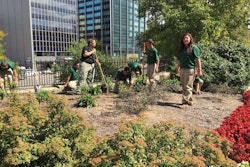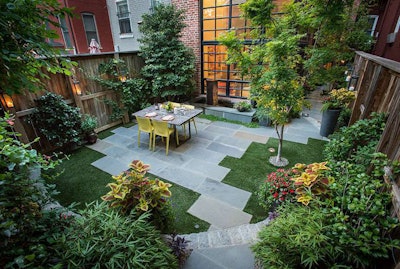 The design of this small backyard packs greenery, hardscaping and seating into a 22-by-22-foot area.
The design of this small backyard packs greenery, hardscaping and seating into a 22-by-22-foot area.Photo: Botanical Decorators
Urban locations have a lot to offer, but spacious outdoor areas are few and far between. After spending significant time in the concrete jungle, it’s nice to escape from the claustrophobia with a green oasis.
Here are some design tips for turning these Lilliputian landscapes into petite paradises:
Break it up
As counterintuitive as it sounds, breaking a small backyard up into smaller spaces actually helps. By creating defined, separate areas, the backyard now has various destinations that make the area feel larger.
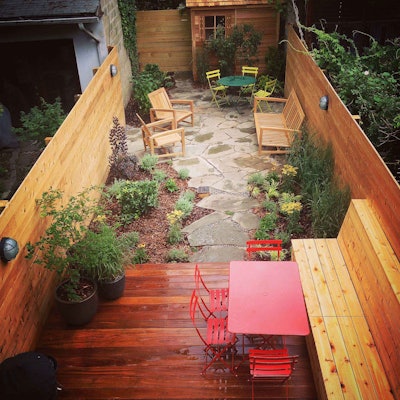 This longer garden is broken into different areas with the use of contrasting hardscapes.
This longer garden is broken into different areas with the use of contrasting hardscapes.Photo: New Eco Landscapes
“Think ‘miniature golf course,’” says Ketti Kupper, owner and principle designer of Conscious Living Landscapes in Los Angeles, California. “Packing multiple zones into a small space is more fun and engaging.”
The shape of the backyard will determine how you should go about breaking up the landscape. If it is a long, rectangular space, you’ll want to break up the bowling-alley feel. Create divides, which will stop the eye from going straight to the back of the property but still give you small glimpses of what is beyond.
Don’t try to create multiple “rooms” in the outdoor area if there simply isn’t enough space for them to be usable.
“Design your space so that different rooms are open to each other and can share space when necessary,” says Sean Lewis, senior designer at New Eco Landscapes in New York. “Elements like lighting, pergolas or built-ins can define a zone without actually cutting off the open flow of your garden.”
Keep it simple
This may sound like a no-brainer, but when you’re trying to create your different zones, don’t end up making the design cluttered. Streamline your use of materials with elements such as built-in seating to maximize the space.
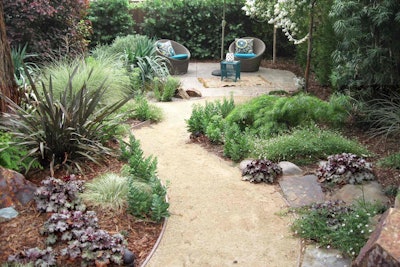 A winding path makes the space seem larger.
A winding path makes the space seem larger.Photo: Ketti Kupper
“A lot of the time they want to squeeze a lot of things in and it makes it seem smaller,” says Christopher Cahill, president of Botanical Decorators in Olney, Maryland.
Instead of cramming in 20 planter pots, shrink the number to five. By limiting the amount of materials you use, whether in building or planting, the design retains a unified, open feel.
“Avoid using too many garden floor textures or patterns,” Kupper says. “Restricting hardscape to two to three materials is helpful.”
It is important to design the usable spaces first, then move on to adding plant materials to the remaining areas.
Add a focal point
Luxury backyard elements may seem like unlikely candidates to add to to a tiny backyard, but if your design is uncluttered, these can serve as a focal point.
By drawing the eye to a unique water feature or fire pit, such a design fixes attention on that character piece instead of the size of the backyard.
“These type of features can be designed to do double duty as a bench, sitting area or a table for example,” Kupper says.
When it comes to major design elements such as a fire or water feature, however, you’ll need to choose just one.
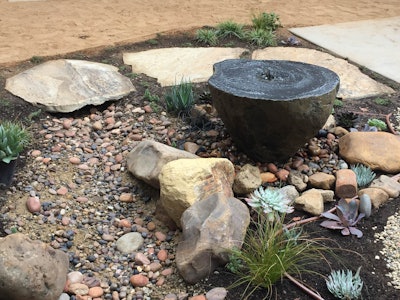 This water feature is an example of using a detailed focal point set against a background of simple shapes.
This water feature is an example of using a detailed focal point set against a background of simple shapes.Photo: Ketti Kupper
“I would limit it to one focal point that the garden could be designed around,” Cahill says. “Water neutralizes city sounds and makes the area much more comfortable.”
Having a focal point causes the viewer to pause and take in the area more slowly, rather reaching to the end of the garden.
“If a luxury element is something you love and will use, then include it, but keep other choices limited,” Lewis says. “You may need to limit the plants and furniture you include to make room for that element.”
Other possible options for focal points are thin, tall trees such as columnar hornbeams or columnar sweetgums. A line of these types of trees can also create some much needed privacy in urban areas.
Break through the boundaries
It is crucial to use irregular shapes when adding a patio to a small garden because placing a concrete square inside a slightly bigger square is going to eat up what little opportunity you have for planting.
“The big mistake that most companies make is that they try to work in the ideas of a traditional patio within the space and you need to let the space define what shape the patio should be,” Cahill says.
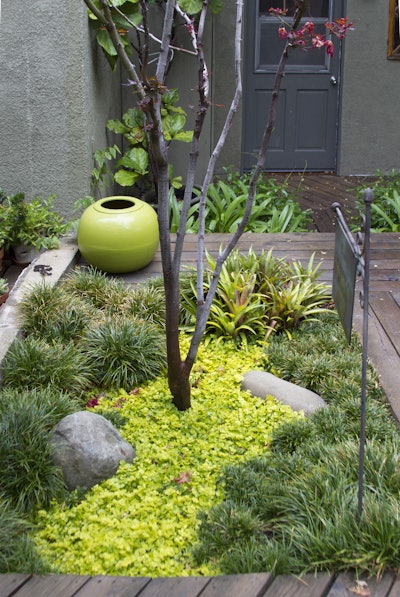 Here’s an example of how using swaths of color can create a calming and de-cluttered sensation. Changes of scale with dwarf and large Mondo grass add interest.
Here’s an example of how using swaths of color can create a calming and de-cluttered sensation. Changes of scale with dwarf and large Mondo grass add interest.Photo: Ketti Kupper
By using a triangular or circular shaped patio, you’ll have more space left to add plantings. Using circles throughout the design can soften boundaries and create a circuitous route for the eye, effectively extending its journey throughout the space.
Just because you can’t have large trees in a small space doesn’t necessarily mean that you have to forgo all hopes of greenery. Dwarf varieties of shrubs and perennials can provide color without taking over the area.
“We like to use all kinds of vines because they add lots of greenery without taking up too much floor space,” Lewis says. “Usually a fence or a trellis will take up less space than a hedge, so we often opt for hardscaping solutions.”
Because space is so limited, get creative with where you put your greenery as well.
“You can use green walls to create lush gardens at the very back,” Cahill says.
In the end, a small garden is what you make of it. You can either focus on what you don’t have or tap the potential of what you do have.



